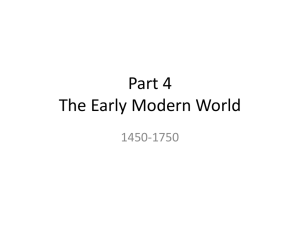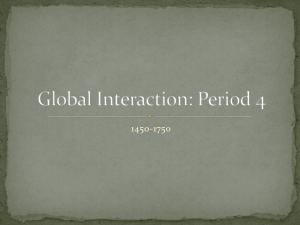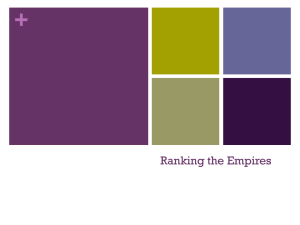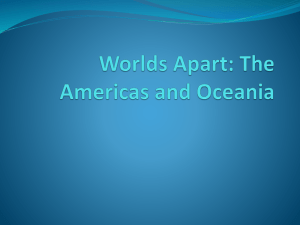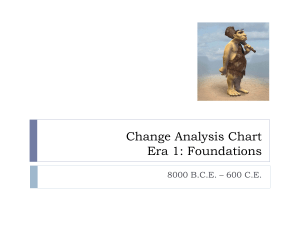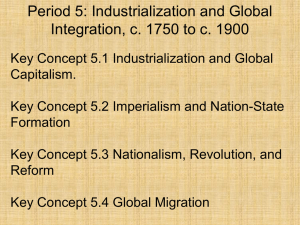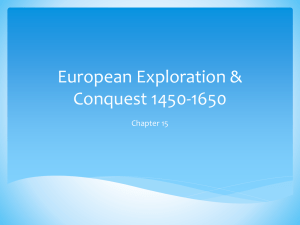WH-TCI-CH.10 - World History
advertisement
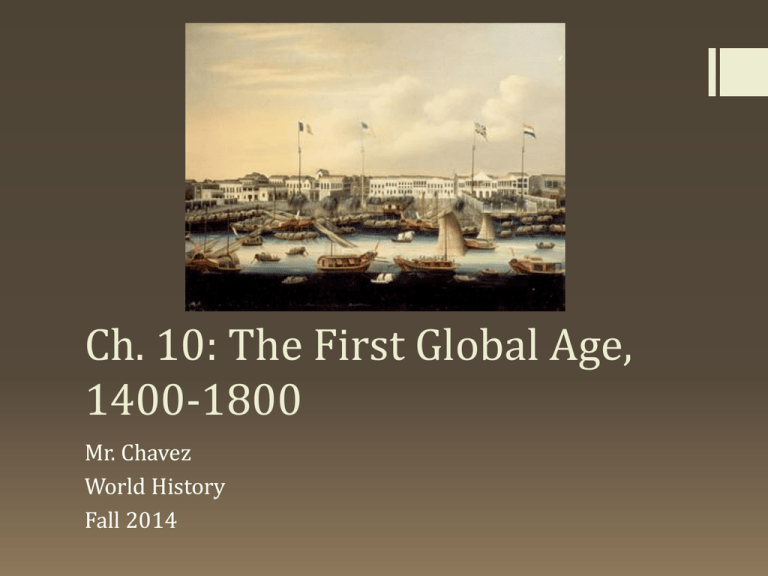
Ch. 10: The First Global Age, 1400-1800 Mr. Chavez World History Fall 2014 10.3: The Growth of State PowerAbsolute Rule in Europe As the world expanded, the power of states and empires also grew Between the 16th and 18th centuries, many monarchs (kings) centralized power and authority This form of rule was known as absolutism Absolute monarchs claimed that their right to rule came from God This notion of God-given authority was known as divine right 10.3: The Growth of State PowerAbsolute Rule in Europe European monarchs backed up their rule with military force They wanted to secure their borders and expand their area of control They used modernized weaponry based on gunpowder technology from China They developed canons for land and sea Developed new methods to fortify artillery attacks Monarchs paid for their new military power by raising taxes and bank loans Gunpowder Revolution! 10.3: The Growth of State PowerGunpowder Empires Gunpowder revolution took place in Europe, eastern Europe and Asia Strong states used gunpowder weapons to conquer territory and build large empires The Ottoman Turks built one of the most powerful empires They relied on well-trained armies and heavily artillery Ottoman Turks created a centralized state to support their empire Their complex system of managing their government was also known as a ________________ BUREAUCRACY The Ottoman Empire Modern Day Turkey Majority of Turkish people are Muslim. Can you guess which branch of Islam? Sunni 10.3: The Growth of State PowerGunpowder Empires To the north, Russia also built a powerful state empire 10.3: The Growth of State PowerGunpowder Empires In Persia, the Safavid Empire arose in 1501 and collapsed in 1722 Their greatest ruler, Shah Abbas, built a strong centralized state and promoted art and architecture This branch of Islam was practiced in this empire: ________________. The Mughal Empire spread across Central Asia and India Lasted from 1526 to 1707 Also had a strong central government Government grew rich from trading cotton and spices Shi’a The Safavid and Mughal Empires 10.3: The Growth of State PowerEmerging European Dominance Despite their success, most of the gunpowder empires declined by the late 1700s Safavid, Ottoman, Mughal In contrast, Europe was getting stronger 1 major factor: Commercial Revolution Rapid expansion of business Fueled by overseas trade and colonization Gave rise to early forms of capitalism European states became extremely wealthy as a result Increased their military and political power Economic, Political, Social, and Cultural factors helped Europe rise to power once more Europe’s Rise to Power! Now It’s Your Turn! Answer the following questions in complete sentences. Title it Now It’s Your Turn Write your responses on the back of your notes 1. Describe 2 ways that monarchs centralized their power. 2. How did the Commercial Revolution make Europe powerful? 10.4: Atlantic Empires: Colonization of the Americas By establishing American colonies, western European countries… Built new empires Created new networks of exchange New colonies had both positive and negative effects on the rest of the world Spain and Portugal established first American colonies Spain colonized North and South America in the 1500s Portugal colonized Brazil in the 1500s _________________ defeated the Aztec and Inca empires Brought millions of Indians under their control Conquistadors 10.4: Atlantic Empires: Colonization of the Americas Social structure of the Spanish colonies was largely based on race White colonists made up the top social class They enjoyed the most power and privileges Next were _______________: mixed race descendants of Europeans and Indian At the bottom were native Indians; later black Africans Mestizos 10.4: Atlantic Empires: Colonization of the Americas The Catholic Church also played an important role in colonial society The spread of Catholic beliefs was a prime motive of the Spanish conquest Spanish and Portuguese Empires 10.4: Atlantic Empires: Economies of Silver Silver mining became the main economic activity in the Spanish colonies Spanish forced Indians to work in the mines Silver had an enormous impact on the world economy Made into coins and increased world money supply Resulted in ________________: rising prices, usually caused by an increase in money supply The plantation system: Spanish crown granted colonists large estates, stripping away land from Indians Plantations grew: sugar, tobacco, cacao, cotton, etc.. inflation 10.4: Atlantic Empires: A Continental Exchange Exchange of goods between the Old World and the New World This was also known as the _____________________: the transfer of plants, animals and diseases between the Eastern and Western hemispheres Columbian Exchange • The Columbian Exchange also had negative effects • Worst of all, Old World diseases spread rapidly, with deadly effects on Indian populations The Columbian Exchange 10.4: Atlantic Empires: Death and Slavery Old World diseases killed at least 50% of the native population Amounted to tens of millions of people This event is called the ________________. The spread of disease made the European conquest of the Americas much easier Less Indians to resist European colonists Also, less Indians to work the land Europeans started to import African slaves as a result Great Dying 10.4: Atlantic Empires: Death and Slavery Slavery has existed since ancient times Greeks, Romans and Arabs had all used slaves before Major were prisoners of war The first African slaves were bought by Portugal in the mid-1400s By the mid-1500s, most European countries were in the practice of buying slaves as well By the 1800s, more than ten million African slaves had been shipped to the Americas Approximately 1 out of every 6 died en route to the Americas (approximately 2 million) The journey from Africa to the Americas was known as the middle passage 10.4: Atlantic Empires: Death and Slavery The slave trade had a major impact on Africa Slavery destroyed many African societies It strengthened African warlords who sold slaves It introduced European goods, including guns to Africa The slave trade had a greater impact on the Americas Slavery supported the plantation system which was violent and brutal Left a legacy of racism and inequality that still exists today Slavery in the Americas 10.5: Movement of Religion & Ideas: Spreading Faith in the Americas As regions became more connected, ideas and religious beliefs spread more rapidly from place to place Movement of ideas and religion also helped transform the world Colonization of the Americas brought 2 LARGE continents into the Christian world Catholic priests converted millions of Indians to Christianity Many/most were converted forcefully In most cases, Indians blended Christian teachings with their own traditional beliefs Catholic missionaries spread the faith into Africa and Asia 10.5: Movement of Religion and Ideas: New Ideas in Europe New ideas and ways of thinking arose in Europe Artist and thinkers of theRenaissance __________________, revived classical art and culture. They promotedHumanism ______________, a belief in the value of the individual This new way of thinking paved the way for the Reformation ____________, which split the Catholic Church and gave birth to new Protestant religions 10.5: Movement of Religion and Ideas: New Ideas in Europe The printing press was crucial to the Reformation And to ideas in general Printing technology invented by China in the 11th century German metalworker, Johannes Gutenberg advanced the technology in 1450 His printing press could print 300 pages in one day Printing became faster and more efficient 10.5: Movement of Religion and Ideas: New Ideas in Europe This movement sought to revive Catholicism in Counter-Reformation response to the Reformation: _________________ The church expanded its missionary work in the new colonies Scholars and thinkers, inspired by the Renaissance, began to study the natural world in new ways Scientific Revolution This new approach to learning was called ______________ Began in the mid-1500s and lasted through the 1600s Beginning in the 1700s, this movement sought to apply scientific methods to the study of society and its problems Enlightenment _________________________


